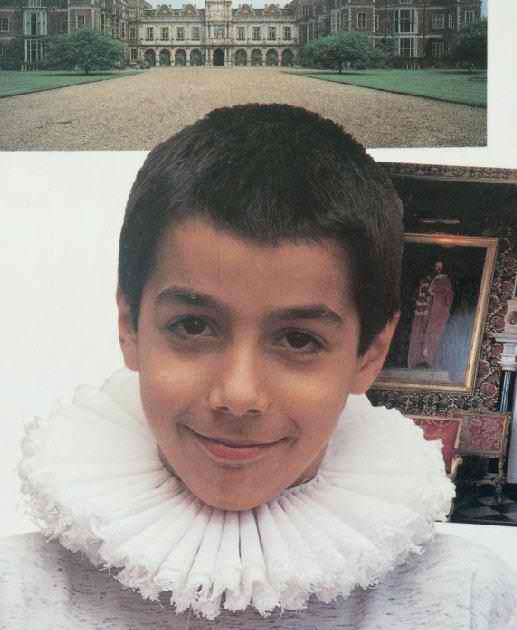
Ruffs

Figure 1.--Here a modern boy models an Elizabethan ruff. The image comes from an excellent English educational book, "Lets Discover - A Stuart House". After the turn of the 17th century and the succession of the Stewarts to replace Elizabeth in 1603, the ruff gradually went out of fashion.
|
|
The most elaborate collar was the ruffs worn my men and boys as well as women in the 16th century. The ruff is so destincrive and worn during such a descrete rime period that for many it epitomizes the 16th century. The ruff began the 16th century as a small, moddest pleated ruffle on shirt collars. As fashion sometimes develop, the ruff became so popular that people gradually made them larger and larger. Eventually ruffs became massive neck peace looking like an intricately constructed wheel-like neck piece. Specialized tools had to be developed to keep them pleated. By the late 16th century, these ruffs had become so large and unwieldly that wearers had to have special supports. These were called 'rebatos' or 'supportasses'. They were commonly half-moon shaped and situated at the back of the collar to keep it at a fashionable, slightly upright angle. Paintings of all the great men and women of Elizabethan England wore ruffs, including Queen Elizabeth. They were widely worn accross the Channel in France, Spain, and other countries as well. Both the English and Spanish officers who fought in and against the Great Armada wore ruffs. A ruff was a neckpiece more than a collar. I was not attahed to any shirt-like garment. It was made of lace, lawn, or other cotton fabric. Cotton was an expensive material in the 16th century as it had to be imported. It was gathered or drawn into deep, full, symetrical folds. They were heavily starched to keep them stiff. It was very popular with men and women in the 16th century. Given the cost of purchasing and maintaining these ruffs, it would be primarly affluent people who wore them. After the turn of the 17th century and the succession of the Stewarts to replace Elizabeth in 1603, the ruff gradually went out of fashion. They have not totaly disappeared in the modrn world. They are still worn by some English boys' choirs.
The most elaborate collar was the ruffs worn my men and boys as well as women in the 16th century. The ruff is so destincrive and worn during such a descrete rime period that for many it epitomizes the 16th century.
Chronology
The ruff began the 16th century as a small, moddest
pleated ruffle on shirt collars. As fashion sometimes develop, the ruff became so popular that people gradually made them larger and larger. After the turn of the 17th century and the succession of the Stewarts to replace Elizabeth in 1603, the ruff gradually went out of fashion.
Paintngs
Paintings of all the great men and women of Elizabethan England wore ruffs, including Queen Elizabeth. They were widely worn accross the Channel in France, Spain, and other countries as well. Both the Emglish and Spanish officers who fought in and against the Great Armada wore ruffs.
Description
A ruff was a neckpiece more than a collar. I was not attcahed to any shirt-like garment. It was gathered or drawn into deep, full, symetrical folds. They were heavily starched to keep them stiff. It was very popuar with men and women in the 16th century. Eventually ruffs became massive neck peace looking like an intricately constructed wheel-like neck piece. Specialized tools had to be developed to keep them pleated.
Material
It was made of lace, lawn, or other cotton fabric. Cotton was an exspensive material in the 16th century as it had to be impoprted.
Ruff Supporters
By the late 16th century, these ruffs had become so large and unwieldly that wearers had to have special supports. These were called 'rebatos' or 'supportasses'. They were commonly half-moon shaped and situated at the back of the collar to keep it at a fashionable, slightly upright angle.
Social Class
Given the cost of purchasing and maintaining these ruffs, it would be primarly affluent people who wore them.
Moden Ruffs
Ruffs have not totaly disappeared in the modrn world. They are still worn by some English boys' choirs. A British reader tells us that we should have said have British choirs. We were not familiar with boy choirs in Wales, Ulster, and Scotland, but apparently there are some. "There are choirs with boys' voices in Scots and Welsh Cathedrals, also in Ireland north and south. Many are beruffed or wear Eton collars." He reports that he has also see them worn by boys in German choirs and there must be choir in America, Australia, Canafa, and New Zealand where they were worn.
Christopher Wagner

Navigate the Historic Boys' Clothing Web Site:
[Return to the Main collar style page]
[Introduction]
[Activities]
[Biographies]
[Chronology]
[Clothing styles]
[Countries]
[Topics]
[Bibliographies]
[Contributions]
[FAQs]
[Glossaries]
[Images]
[Links]
[Registration]
[Tools]
[Boys' Clothing Home]
Navigate the Historic Boys' Clothing Web chronological pages:
[The 15th century]
[The 16th century]
[The 17th century]
[The 18th century]
Navigate the Historic Boys' Clothing Web style pages:
[Long pants]
[Knickers]
[Short pants]
[Scottish kilts]
[School uniform]
[Sailor suits]
[Eton suits]
[Ring bearer/page costumes]
[English boy choirs]
Created: October 18, 2002
Last updated: October 21, 2002



